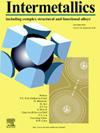真空等离子喷涂AlCoCrFeNi高熵合金结合层:真空热处理、显微组织演变及氧化行为分析
IF 4.3
2区 材料科学
Q2 CHEMISTRY, PHYSICAL
引用次数: 0
摘要
采用真空等离子体喷涂(VPS)技术制备了高熵合金(HEA)键合涂层,然后在1050℃下进行真空热处理(VHT) 5 h。本研究严格研究了VHT工艺对AlCoCrFeNi涂层显微组织演变和抗氧化性的影响。实验结果表明,在1000℃的氧化条件下,喷涂态和热处理态涂层均形成以α-Al2O3为主的热生长氧化物(TGO)层。值得注意的是,vht处理的涂层表现出增强的抗氧化性,在1000°C氧化50小时后,与未处理的涂层相比,TGO层厚度减少了12.3%。这种改善归因于VHT过程中微观组织的变化,包括晶粒粗化和晶界密度的降低,这些变化共同减少了Al离子向外扩散。相分析表明,真空热处理后的AlCoCrFeNi涂层由初始的BCC结构转变为BCC + FCC + σ-相结构。FCC相的出现导致涂层硬度降低23%(从506.1 HV降至388.8 HV),这有助于TGO/涂层界面的应力松弛,降低裂纹萌生的可能性。总之,本研究为提高高熵合金的抗氧化性提供了一种简单有效的方法。本文章由计算机程序翻译,如有差异,请以英文原文为准。
Vacuum plasma sprayed AlCoCrFeNi high-entropy alloy bond Coating: Vacuum heat-treatment, microstructure evolution and oxidation behavior analysis
The AlCoCrFeNi high-entropy alloy (HEA) bond coating is fabricated using vacuum plasma spray (VPS) technology, followed by a vacuum heat treatment (VHT) at 1050 °C for 5 h. This study rigorously investigates the effects of the VHT process on the microstructural evolution and oxidation resistance of the AlCoCrFeNi coating. The experimental findings indicate that both the as-sprayed and heat-treated coatings develop thermally grown oxide (TGO) layers predominantly composed of α-Al2O3 under oxidation conditions up to 1000 °C. Notably, the VHT-treated coating exhibits enhanced oxidation resistance, showing a 12.3 % reduction in TGO layer thickness after 50 h of oxidation at 1000 °C, compared to its untreated counterpart. This improvement is attributed to the microstructural changes during VHT, including grain coarsening and a decrease in grain boundary density, which collectively reduce the diffusion of Al ions outward. Additionally, phase analysis demonstrates that the AlCoCrFeNi coating transitions from an initial BCC structure to a BCC + FCC + σ-phase following vacuum heat treatment. The emergence of the FCC phase leads to a 23 % reduction in coating hardness (from 506.1 HV to 388.8 HV), which aids in stress relaxation at the TGO/coating interface and reduces the likelihood of crack initiation. Overall, this research, which offers a simple and effective method for enhancing the oxidation resistance of high entropy alloys.
求助全文
通过发布文献求助,成功后即可免费获取论文全文。
去求助
来源期刊

Intermetallics
工程技术-材料科学:综合
CiteScore
7.80
自引率
9.10%
发文量
291
审稿时长
37 days
期刊介绍:
This journal is a platform for publishing innovative research and overviews for advancing our understanding of the structure, property, and functionality of complex metallic alloys, including intermetallics, metallic glasses, and high entropy alloys.
The journal reports the science and engineering of metallic materials in the following aspects:
Theories and experiments which address the relationship between property and structure in all length scales.
Physical modeling and numerical simulations which provide a comprehensive understanding of experimental observations.
Stimulated methodologies to characterize the structure and chemistry of materials that correlate the properties.
Technological applications resulting from the understanding of property-structure relationship in materials.
Novel and cutting-edge results warranting rapid communication.
The journal also publishes special issues on selected topics and overviews by invitation only.
 求助内容:
求助内容: 应助结果提醒方式:
应助结果提醒方式:


